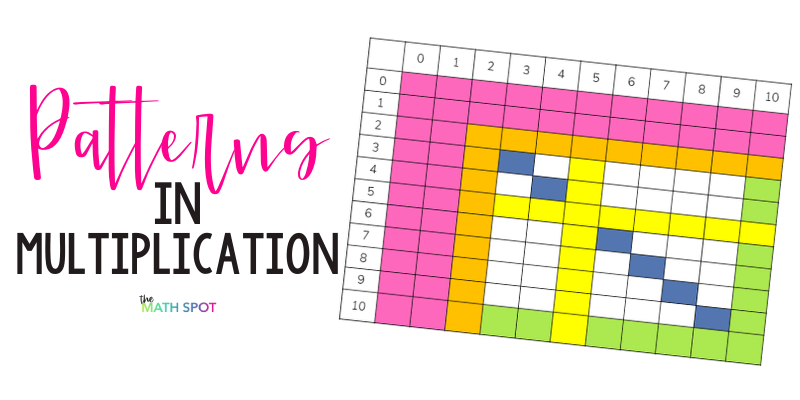This post contains affiliate links. This means that when you make a purchase, at no additional cost to you, I will earn a small commission.
By the conclusion of 3rd grade students should know all products of two one-digit number from memory. If our students are individually learning each fact, they will need to memorize 100 individual facts (over 100 if we add in facts multiplying by 10)! Taking advantage of patterns in multiplication can make this big task much more manageable!

Focusing on 5 simple patterns in multiplication can help your students to develop fluency with their multiplication facts.
Multiplying by 0 or 1
Students who understand that multiplication puts equal groups together can quickly and easily learn their 0 and 1 facts. Consider these simple story problems:
- Ella has 6 piggy banks. She has exactly $0 in each piggy bank. How much money does Ella have in all?
- Ella has 1 piggy bank. She has exactly $8 inside! How much money does Ella have in all?
Relating these story problems to multiplication equations will help your students connect what they know with multiplication equations.
Another way to strengthen your students understanding of patterns in multiplication around multiplying by 0 or 1 is to provide your students with activities that require them to explicitly build and compare what happens when you multiply a number by 0 or 1.

Multiplying by 2
Your students may already know their doubles addition facts. Take advantage of this knowledge and make explicit connections to x2 facts!
‘How do you make these explicit connections? Ask your students to do what they know (doubles addition facts) directly alongside what you want them to understand (x2 multipliction facts). For example, using “doubles” dominoes ask your students to write an addition equation that matches the domino and then ask them to write a multiplication fact that matches the same domino.
Explicitly ask your students about the patterns in multiplication they observe.

Multiplying by 5
Rote counting by 5s is a 2nd grade math standard, when helping your students to develop fact fluency in 3rd grade, take advantage of their prior knowledge!
Your students may not make the connection between skip counting by 5s and multiplication equations on their own so activities that explicitly draw the connection between skip counting and x5 facts can help your students to develop their fluency.
The activity pictured below shows students laying out “high fives” and skip counting to find the total. Simply writing a related multiplication equation can help to draw the connection for your students.

Multiplying by 10
When looking at patterns in multiplication it can be helpful to align patterns your students already know with the multiplication facts you want your students to gain fluency with.
Multiplying by 10 is no different! In this case, we want to align what our students already know about place value with multiplication equations.
Unit form can be a powerful tool to make this connection. Ask your students to build a given decade number using base ten blocks. How could that number be written in unit form? Could your students write a related multiplication equation? Repeating this activity time and time again will help your students to draw connections between place value and multiplication by 10 and will increase your students’ fact fluency.

Exploring Square Numbers
Much like students gravitate towards doubles facts for addition, facts where a number is multiplied by itself in multiplication are pillar facts for our 3rd grade students.
You can help your students to explore these facts using hands-on materials, drawings and equations.
Providing a tool such as linking cubes will allow your students to build arrays for facts such as 2×2, 3×3 and 4×4. Ask your students what they notice about these arrays. Why might the products of these facts be called “square numbers”?
In addition to building with linking cubes, provide your students further opportunities to explore the patterns in multiplication of square numbers by drawing arrays on grid paper and labeling with the corresponding multiplication equation.

Attending to patterns in multiplication can support your students in gaining multiplication fact fluency without having to memorize dozens of individual facts. Allowing your students repeated opportunities to access these facts will increase fluency and ultimately lead to fact memorization as well.
Related Resources
Each of the activities in this blog post are included in the Patterns in Multiplication math intervention unit. This unit includes pre and post assessment, 5 detailed lessons along with independent practice activities ideal for small group math intervention.
This Unit Includes
- Pre and Post Assessment
- 5 Detailed Lesson Plans
- Independent Practice Activities
- Tickets Out The Door


